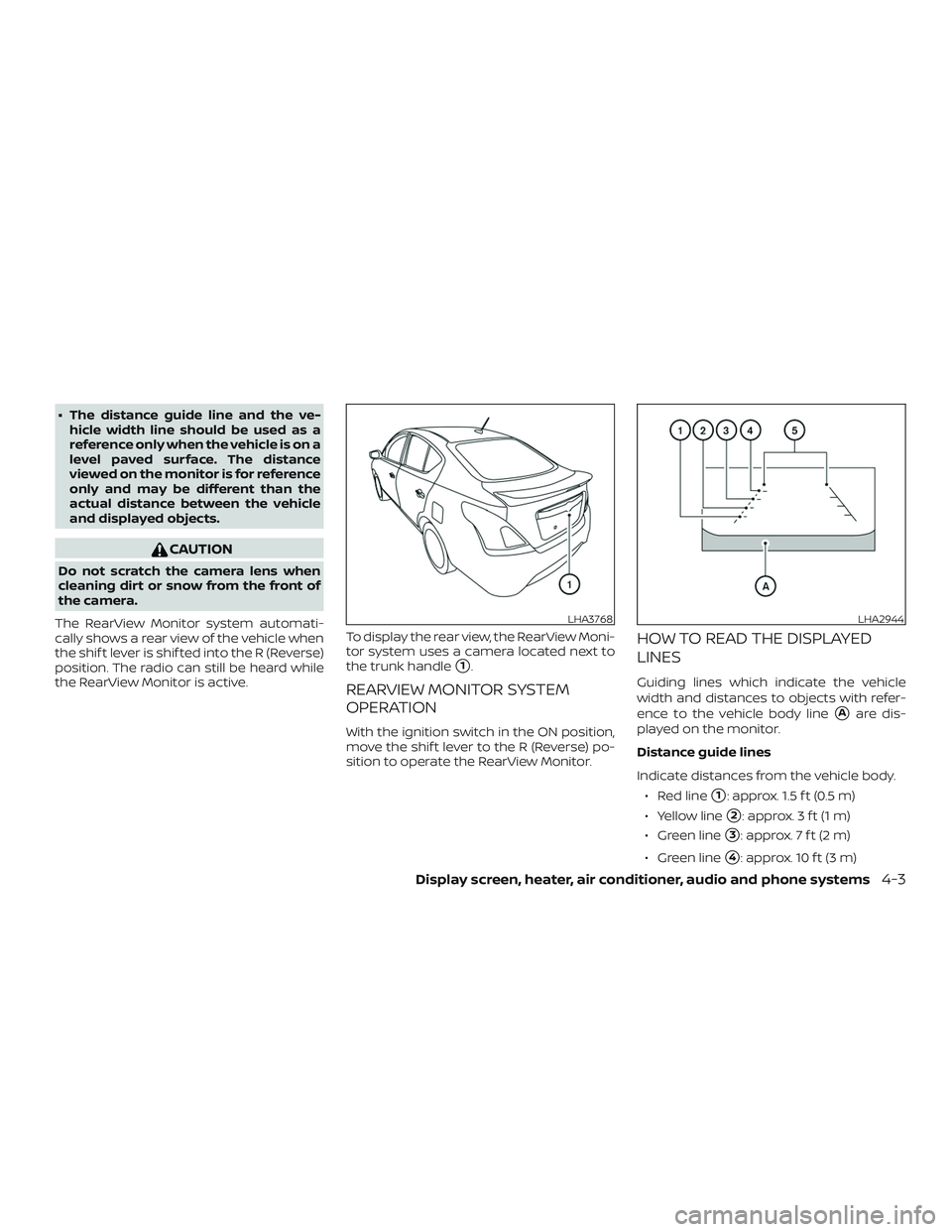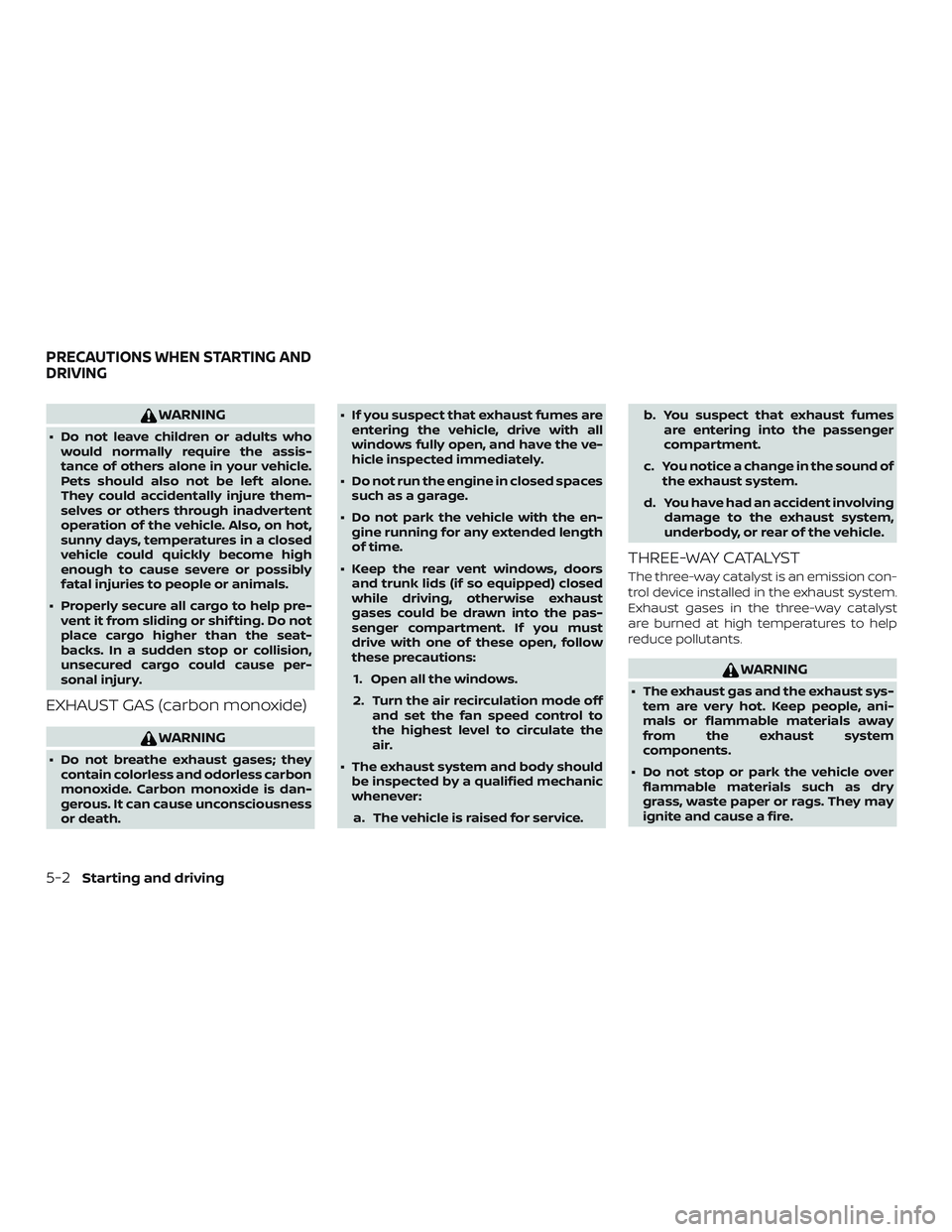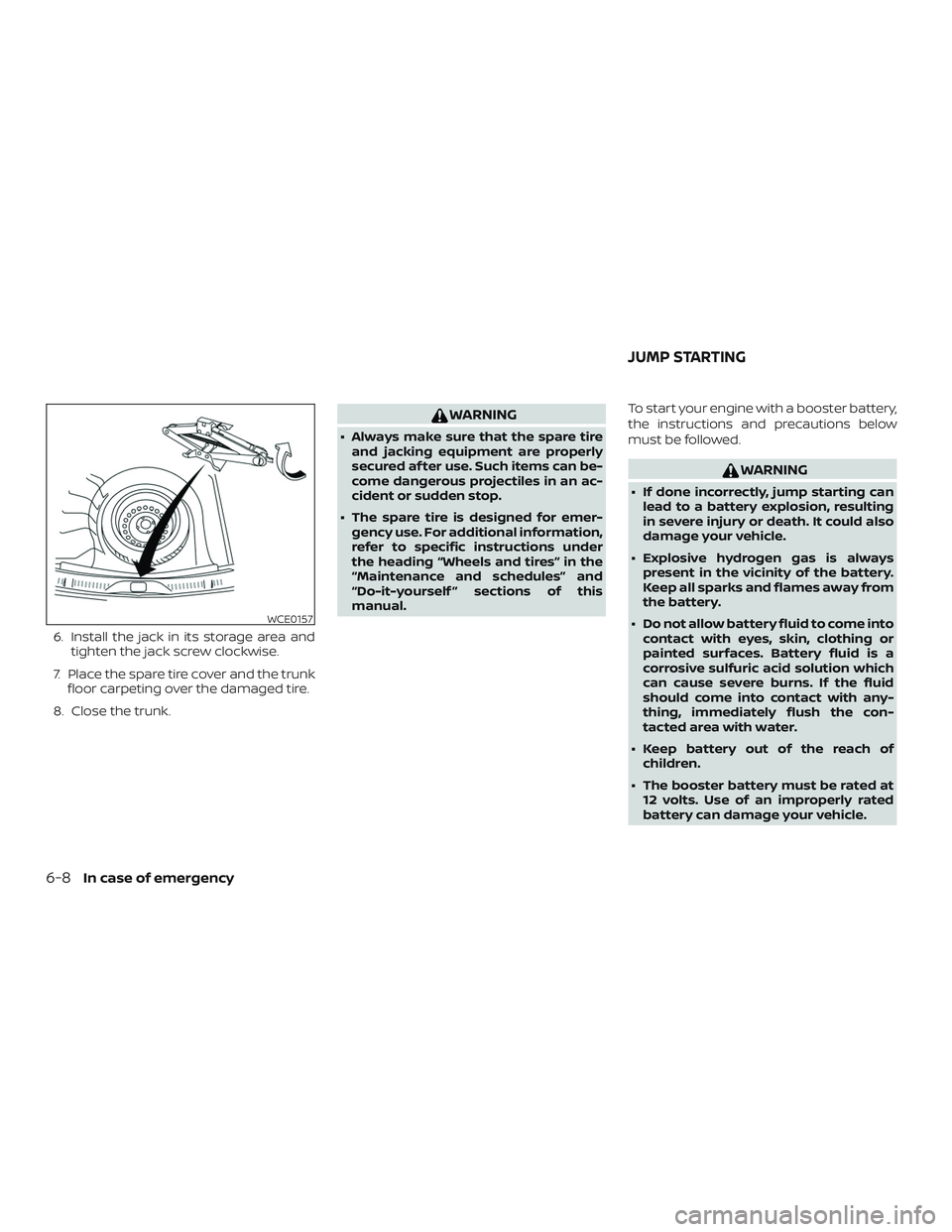Page 138 of 354

∙ The distance guide line and the ve-
hicle width line should be used as a
reference only when the vehicle is on a
level paved surface. The distance
viewed on the monitor is for reference
only and may be different than the
actual distance between the vehicle
and displayed objects.
CAUTION
Do not scratch the camera lens when
cleaning dirt or snow from the front of
the camera.
The RearView Monitor system automati-
cally shows a rear view of the vehicle when
the shif t lever is shif ted into the R (Reverse)
position. The radio can still be heard while
the RearView Monitor is active.To display the rear view, the RearView Moni-
tor system uses a camera located next to
the trunk handle
�1.
REARVIEW MONITOR SYSTEM
OPERATION
With the ignition switch in the ON position,
move the shif t lever to the R (Reverse) po-
sition to operate the RearView Monitor.
HOW TO READ THE DISPLAYED
LINES
Guiding lines which indicate the vehicle
width and distances to objects with refer-
ence to the vehicle body line
�Aare dis-
played on the monitor.
Distance guide lines
Indicate distances from the vehicle body.
∙ Red line
�1: approx. 1.5 f t (0.5 m)
∙ Yellow line
�2: approx. 3 f t (1 m)
∙ Green line
�3: approx. 7 f t (2 m)
∙ Green line
�4: approx. 10 f t (3 m)
LHA3768LHA2944
Display screen, heater, air conditioner, audio and phone systems4-3
Page 142 of 354

7. Press the ENTER/SETTING button to
complete the adjustment.
∙ Do not adjust the display settings of the
RearView Monitor while the vehicle is
moving.
REARVIEW MONITOR SYSTEM
LIMITATIONS
WARNING
Listed below are the system limitations
for RearView Monitor. Failure to operate
the vehicle in accordance with these
system limitations could result in seri-
ous injury or death.
∙ The system cannot completely elimi-
nate blind spots and may not show
every object.
∙ Underneath the bumper and the cor-
ner areas of the bumper cannot be
viewed on the RearView Monitor be-
cause of its monitoring range limita-
tion. The system will not show small
objects below the bumper, and may
not show objects close to the bumper
or on the ground.∙ Objects viewed in the RearView Moni-
tor differ from actual distance be-
cause a wide-angle lens is used.
∙ Objects in the RearView Monitor will
appear visually opposite compared to
when viewed in the rearview and out-
side mirrors.
∙ Use the displayed lines as a reference.
The lines are highly affected by the
number of occupants, fuel level, ve-
hicle position, road conditions and
road grade.
∙ Make sure that the trunk is securely
closed when backing up.
∙ Do not put anything on the rearview
camera. The rearview camera is in-
stalled above the license plate.
∙ When washing the vehicle with high
pressure water, be sure not to spray it
around the camera. Otherwise, water
may enter the camera unit causing
water condensation on the lens, a
malfunction, fire or an electric shock.
∙ Do not strike the camera. It is a preci-
sion instrument. Otherwise, it may
malfunction or cause damage result-
ing in a fire or an electric shock.The following are operating limitations and
do not represent a system malfunction:
∙ When the temperature is extremely
high or low, the screen may not clearly
display objects.
∙ When strong light directly shines on the
camera, objects may not be displayed
clearly.
∙ Vertical lines may be seen in objects on
the screen. This is due to strong re-
flected light from the bumper.
∙ The screen may flicker under fluores-
cent light.
∙ The colors of objects on the RearView
Monitor may differ somewhat from the
actual color of objects.
∙ Objects on the monitor may not be
clear in a dark environment.
∙ There may be a delay when switching
between views.
∙ If dirt, rain or snow accumulate on the
camera, RearView Monitor may not dis-
play objects clearly. Clean the camera.
Display screen, heater, air conditioner, audio and phone systems4-7
Page 213 of 354

WARNING
∙ Do not leave children or adults who
would normally require the assis-
tance of others alone in your vehicle.
Pets should also not be lef t alone.
They could accidentally injure them-
selves or others through inadvertent
operation of the vehicle. Also, on hot,
sunny days, temperatures in a closed
vehicle could quickly become high
enough to cause severe or possibly
fatal injuries to people or animals.
∙ Properly secure all cargo to help pre-
vent it from sliding or shif ting. Do not
place cargo higher than the seat-
backs. In a sudden stop or collision,
unsecured cargo could cause per-
sonal injury.
EXHAUST GAS (carbon monoxide)
WARNING
∙ Do not breathe exhaust gases; they
contain colorless and odorless carbon
monoxide. Carbon monoxide is dan-
gerous. It can cause unconsciousness
or death.∙ If you suspect that exhaust fumes are
entering the vehicle, drive with all
windows fully open, and have the ve-
hicle inspected immediately.
∙ Do not run the engine in closed spaces
such as a garage.
∙ Do not park the vehicle with the en-
gine running for any extended length
of time.
∙ Keep the rear vent windows, doors
and trunk lids (if so equipped) closed
while driving, otherwise exhaust
gases could be drawn into the pas-
senger compartment. If you must
drive with one of these open, follow
these precautions:
1. Open all the windows.
2. Turn the air recirculation mode off
and set the fan speed control to
the highest level to circulate the
air.
∙ The exhaust system and body should
be inspected by a qualified mechanic
whenever:
a. The vehicle is raised for service.b. You suspect that exhaust fumes
are entering into the passenger
compartment.
c. You notice a change in the sound of
the exhaust system.
d. You have had an accident involving
damage to the exhaust system,
underbody, or rear of the vehicle.
THREE-WAY CATALYST
The three-way catalyst is an emission con-
trol device installed in the exhaust system.
Exhaust gases in the three-way catalyst
are burned at high temperatures to help
reduce pollutants.
WARNING
∙ The exhaust gas and the exhaust sys-
tem are very hot. Keep people, ani-
mals or flammable materials away
from the exhaust system
components.
∙ Do not stop or park the vehicle over
flammable materials such as dry
grass, waste paper or rags. They may
ignite and cause a fire.
PRECAUTIONS WHEN STARTING AND
DRIVING
5-2Starting and driving
Page 247 of 354
A. Blocks
B. Flat tire
Blocking wheels
Place suitable blocks at both the front and
back of the wheel diagonally opposite the
flat tire to prevent the vehicle from moving
when it is jacked up.
WARNING
Be sure to block the wheel as the vehicle
may move and result in personal injury.
Getting the spare tire and tools
Open the trunk. Lif t the floorboard�1.
To remove the jack, collapse the jack from
the storage location. If necessary, remove
the spare tire first to easily access the jack.To remove the spare tire, loosen the bolt by
turning counterclockwise. Once free, re-
move the bolt. Remove the spare tire.
LCE2142
LCE2020
SCE0913
6-4In case of emergency
Page 251 of 354

6. Install the jack in its storage area and
tighten the jack screw clockwise.
7. Place the spare tire cover and the trunk
floor carpeting over the damaged tire.
8. Close the trunk.
WARNING
∙ Always make sure that the spare tire
and jacking equipment are properly
secured af ter use. Such items can be-
come dangerous projectiles in an ac-
cident or sudden stop.
∙ The spare tire is designed for emer-
gency use. For additional information,
refer to specific instructions under
the heading “Wheels and tires” in the
“Maintenance and schedules” and
“Do-it-yourself ” sections of this
manual.To start your engine with a booster battery,
the instructions and precautions below
must be followed.
WARNING
∙ If done incorrectly, jump starting can
lead to a battery explosion, resulting
in severe injury or death. It could also
damage your vehicle.
∙ Explosive hydrogen gas is always
present in the vicinity of the battery.
Keep all sparks and flames away from
the battery.
∙ Do not allow battery fluid to come into
contact with eyes, skin, clothing or
painted surfaces. Battery fluid is a
corrosive sulfuric acid solution which
can cause severe burns. If the fluid
should come into contact with any-
thing, immediately flush the con-
tacted area with water.
∙ Keep battery out of the reach of
children.
∙ The booster battery must be rated at
12 volts. Use of an improperly rated
battery can damage your vehicle.
WCE0157
JUMP STARTING
6-8In case of emergency
Page 291 of 354
EXTERIOR AND INTERIOR LIGHTS
Item Wattage (W) Bulb No.
Headlight assembly
High/Low (Halogen) 60/55 HB2
Turn/Position 28/8 3457A
Side marker 5 W5W
Fog light (if so equipped) 55 H11
Room light 8 —
Map light (if so equipped) 5 W5W
Trunk compartment light 3.4 158
High-mounted stop light*
Inside (if so equipped) 16 W16W
Spoiler (if so equipped) — —
Rear combination light*
Turn signal light 21 PY21W
Stop/Tail 21/5 P21/5W
Backup (reversing) 21 P21W
License plate light* 5 W5W
Always check with the Parts Department at a NISSAN dealer for the latest parts informa-
tion.
* It is recommended that you visit a NISSAN dealer for replacement.
8-24Do-it-yourself
Page 292 of 354
1. Map light (if so equipped)
2. Room light
3. Headlight assembly
4. Fog light (if so equipped)
5. High-mounted stop light (spoiler)
(if so equipped)
6. License plate light
7. Trunk light
8. High-mounted stop light (inside)
(if so equipped)
9. Rear combination light
LDI3124
Do-it-yourself8-25
Page 294 of 354
To change the stop/tail, turn signal or
backup (reversing) light bulbs, perform the
following:
1. Disconnect the negative battery cable.
Trunk light
LDI2135
License plate light
JVC0014XRear combination lightLDI2807
Do-it-yourself8-27